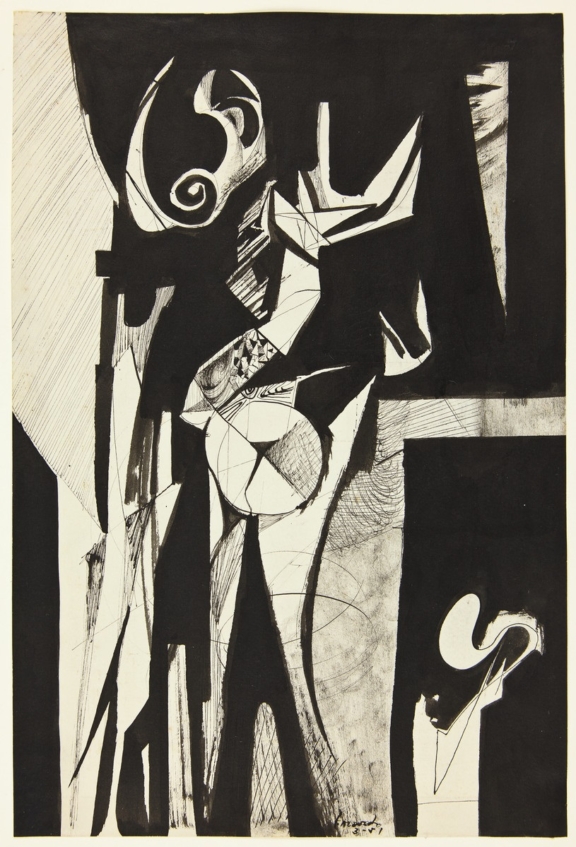
- 1951
- Paper
- Indian ink
- Inv. DP439
Fernando de Azevedo
Ocultação
The history of Surrealism is uniquely marked by occultations, an approach whose origin can probably be found in the overpaintings of Max Ernst. For Fernando de Azevedo and other Portuguese artists of the 1940s, they played an important part in the transition to non-figurative art and the assumption of happenstance and the unconscious. This process facilitated the discovery and the emergence of the unknown within each one – “After all, behind the exercise is the human being”.*
Azevedo produced his first occultation in 1948, before he started using the technique with photography. The two occultations that he presented at an exhibition held by the Surrealist Group in 1949 have since been lost.
At an exhibition held in 1952 at the Casa Jalco, Azevedo presented nineteen occultations (in addition to paintings, drawings, collages and a mannequin). One of these, Personagens Preciosas (Precious Characters, 1950/51), is considered to be a key piece within his oeuvre, as it refers to the “occultation” process, despite being an oil painting.
Like the artist’s collages and many of his paintings, his occultations represent the negation of the figure-background principle. India ink is spread over printed images torn from magazines, or, less frequently, over the artist’s own drawings. Shapes are formed from the areas left bare, in compositions treated to the risk of irreversibility.
Azevedo’s occultations are at once dynamic and delicate, fluid and complex. The grotesque and the poetic, the vegetal or vaguely animal motif and geometric force, organic and mechanical plasticity coexist within them. Those created from printed pages are more adept at capturing this kinetic state, a constant feeling that something is imminent, that something is being at once unveiled and withheld, of epiphany. The light that they project through a gradual, contrasting chiaroscuro and the treatment of their sculptural volume gives the forms a disconcerting, malleable and vulnerable plasticity.
The ghostly aspect to the figures – sharp, bulging, stringy, spongy, ridged, polished, nuanced – is also present in Azevedo’s own occulted drawings, but in this case the relative rigidity brought on by the underlying sense of risk gives them greater weight, a heightened sense of stability, and at times a certain roughness. In the drawings from the CAM collection, some figuration survives the abstraction, and the space is arranged in a more architectural way.
What is hidden and guessed at in these images might be the exact mirror image of what is shown and unveiled, were it not for the respective difference in potential – the cropped image is necessarily the result of a selection of a shape in the abyss that has begun, and succeeds it in a kind of triumph, despite the ostensible fragility of its setting.
Leonor Nazaré
March 2013
* Fernando de Azevedo, quoted by Isabel Coutinho Cabral in “Fernando de Azevedo: da ocultação à pintura, da pintura à colagem”, in Colóquio Artes, nº. 66, September 1985.
| Type | Value | Unit | Section |
| Width | 21,5 | cm | |
| Height | 32,2 | cm |
| Type | signature |
| Type | date |
| Type | A definir |
